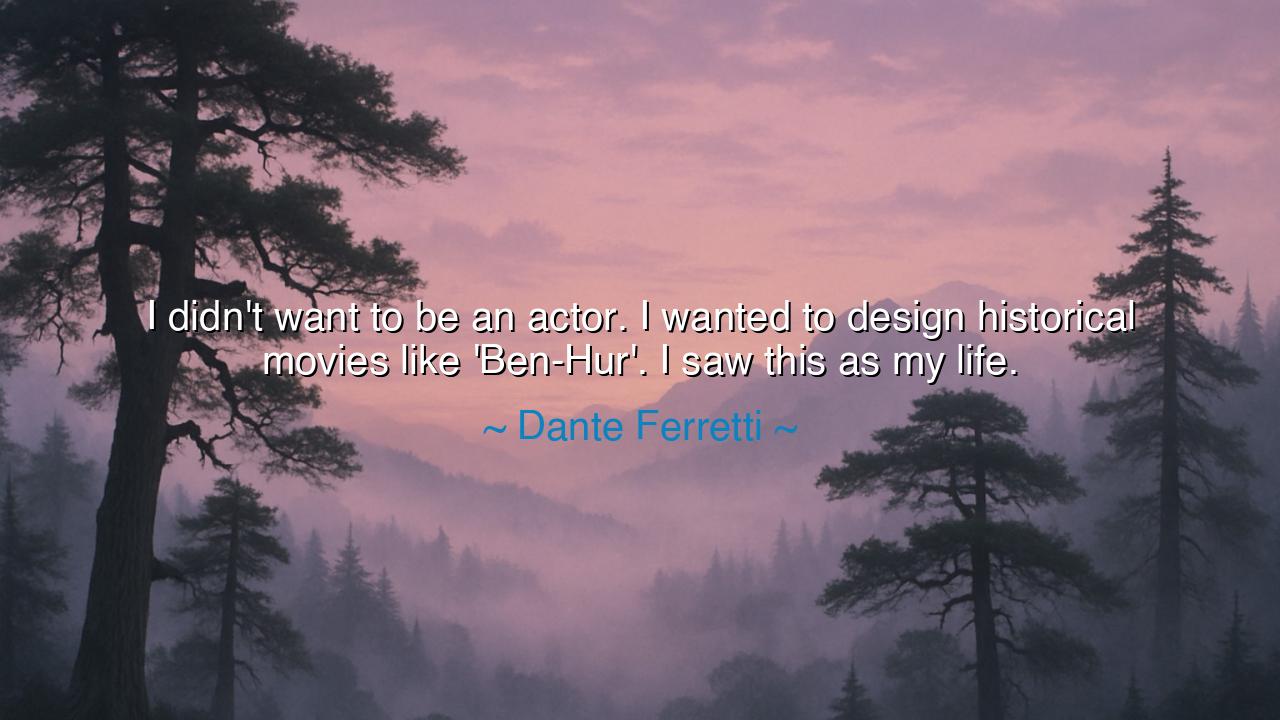
I didn't want to be an actor. I wanted to design historical
I didn't want to be an actor. I wanted to design historical movies like 'Ben-Hur'. I saw this as my life.






In the words of Dante Ferretti, the master of worlds both imagined and historical, there echoes a truth born of devotion and destiny: “I didn’t want to be an actor. I wanted to design historical movies like ‘Ben-Hur.’ I saw this as my life.” These words, though humble in sound, burn with the quiet fire of vocation — the sacred call that draws one not toward fame, but toward purpose. Ferretti, whose artistry has given life to films of grand vision and timeless beauty, speaks not of ambition, but of belonging — the realization that creation, not applause, was his chosen path.
The origin of this declaration lies in Ferretti’s early years in Italy, a country steeped in art, faith, and the lingering majesty of history. Raised among the shadows of cathedrals and ruins, he saw the world not as empty space, but as a stage upon which the past still breathed. When others dreamed of performing beneath the lights, he dreamed of building the world around them. For him, the craft of production design — shaping the visual universe of film — was not mere decoration; it was storytelling itself. In the grand sets of ‘Ben-Hur’, he saw not spectacle, but devotion — the hand of men who turned imagination into architecture, wood and stone into myth.
Ferretti’s words reveal the soul of the true artist — one who does not seek the stage, but the foundation upon which the stage is built. The actor may embody the moment, but the designer creates the world in which the moment lives. His calling was to design historical movies, to resurrect civilizations long gone — Rome in its glory, Florence in its splendor, the Middle Ages in their mystery. He was not content to pretend; he sought to rebuild memory itself. And in this he reflects a truth as old as creation: that the greatest art lies not in imitation, but in reconstruction — the act of breathing life into what time has forgotten.
Consider the story of the ancient architects of Egypt, who built temples not for fame, but for eternity. Their names, for the most part, are lost, but their works still stand — the Pyramids, the tombs, the cities of the dead. They were not the pharaohs upon the throne, nor the priests before the altar, but the unseen hands that shaped the space where the divine and mortal met. Ferretti’s work, like theirs, belongs to this lineage. His designs for films such as The Name of the Rose, The Age of Innocence, and Hugo did not simply recreate history; they evoked its spirit. The viewer, stepping into those worlds, feels not as though watching a film, but as though wandering through a dream of centuries.
In his refusal to become an actor, Ferretti teaches a subtle but vital wisdom — that fulfillment does not come from being seen, but from seeing clearly one’s place in the great design. The world tempts many with the spotlight, promising glory and recognition, but the true creator finds peace in the shadows, shaping the light itself. Ferretti’s calling was not to stand before the camera, but to construct the vision through which the camera could see. In that humility lies greatness, for it is the invisible labor of the devoted that sustains the visible splendor of the world.
His mention of ‘Ben-Hur’ is more than admiration; it is reverence for the sacred craft of design. The sets of that film — vast arenas, marble temples, the chariot races — were triumphs not of technology, but of human imagination. They were built, not rendered; carved, not coded. Ferretti saw in them the possibility of cinema as resurrection — a form of art where history could be touched again. That vision, born in the heart of a young boy, became the compass of his life. He saw this, as he said, “as my life” — not as career, not as pursuit, but as the very form his spirit was meant to take.
Therefore, my listener, take this lesson from Dante Ferretti’s path: know the difference between ambition and calling. The first seeks the crown; the second builds the kingdom. Do not chase the gaze of others, for even the brightest light fades when not fed by passion. Instead, listen for the quiet voice within you that whispers what you were made to do — whether it is to act, to design, to write, or to build. Follow that voice with all your strength, for it is there that your life, like Ferretti’s, will find its meaning.
For as he teaches, the true artist does not live for fame, but for creation. He does not seek the applause of the crowd, but the moment when form and purpose become one — when the work itself becomes a mirror of the soul. Let your work, then, be your stage, your temple, your Rome. Build it with love, tend it with patience, and know that though the world may forget your name, the beauty you create will stand — silent, enduring, and eternal — like the great sets of Dante Ferretti, who found his life not in being seen, but in seeing the world anew.






AAdministratorAdministrator
Welcome, honored guests. Please leave a comment, we will respond soon